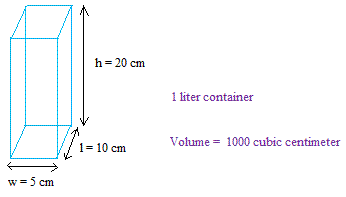Understanding volume
Understanding volume or capacity is especially important in the field of medicine or chemistry when one is dealing constantly with liquid measurement.What is volume or capacity? Although volume and capacity are very similar, there is a tiny difference.
In math, capacity is the amount a container will hold when full while volume refers to the amount of space inside that container.
Capacity is generally measured in milliliters, liters, or kiloliters.Take a look at the following container, which is a rectangular prism.

If the length, width, and height of this three-dimensional container measure 5 cm, 10 cm, and 20 cm respectively, the volume is 5 cm × 10 cm × 20 cm = 1000 cm3
By definition, 1000 cm3 = 1 liter
So, the container above has a volume of 1000 cm3 and a capacity of 1 liter. This container is grossly or approximately the same size and has the same capacity as a large bottle of soda.
Milli is a prefix which refers to a division by 1000 or a multiplication by 0.001.
So, 1 milliliter = 1 liter/1000 = 1000 cm3/1000 = 1 cm3
1 milliliter is grossly the dimension of a container with length, width, and height of 1 cm, 1 cm, and 1 cm respectively since 1 cm × 1 cm × 1 cm = 1 cm3
In real life this could be compared to the capacity of a dose of medicine.
Kilo is prefix which refers to a multiplication by 1000, so 1 kiloliter = 1 liter × 1000 = 1000 liters.
1 kiloliter is approximately the capacity of a king-size water bed.
As you may have noticed, kiloliters are used to measure huge quantity.
Understanding volume or capacity with some more real-life examples.
Items that may require kiloliters to measure them:
- Amount of oil or gas heat in your tank.
- Annual milk production in Massachusetts.
- Amount of water in swimming pool.
Items that may require liters to measure them
- Amount of water consumed in a day by a human being (about 1-6 liters technically. Depends on how thirsty you are)
- A carton of ice cream.
- Amount of milk a cow will give per day.
By the way a cow can probably produce about 4 gallons of milk a day.
Since 1 US gallon = 3.785 liters, 4 gallons = 4 × 3.785 = 15.14 liters.
Items that may require milliliters to measure them:
- A glass of water.
- A one scoop ice cream.
- A bottle of perfume.